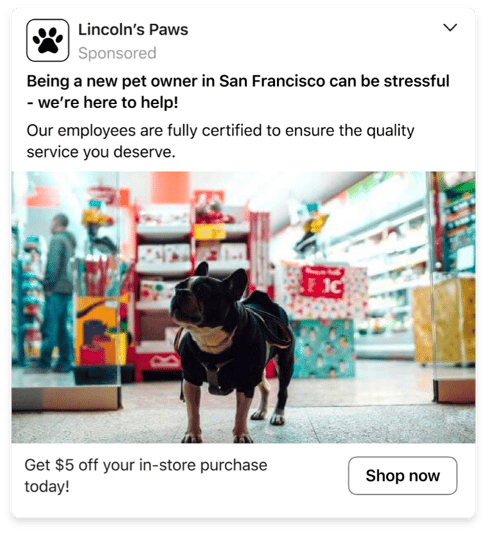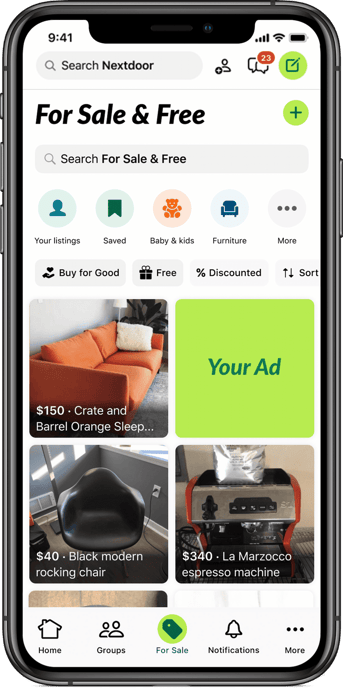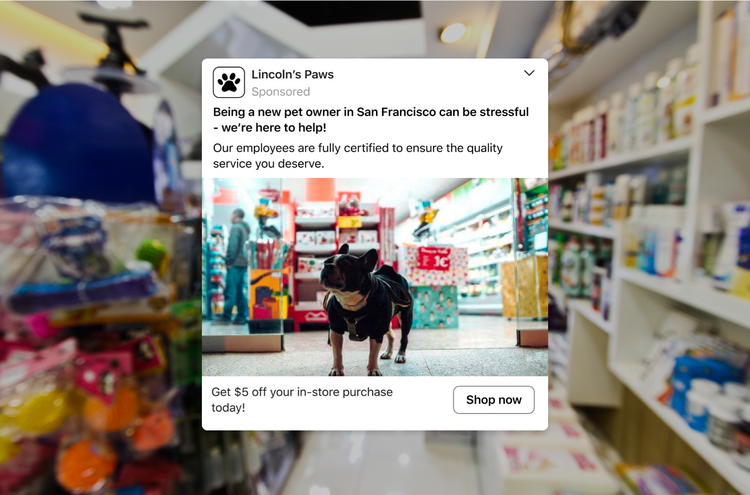Nextdoor is built for the neighborhood. From local businesses and services to nonprofits and civic organizations, Nextdoor connects neighbors to each other and everything in between - including your brand. The Neighborhood Ad Center (NAC), which is currently in beta and available to a limited number of businesses, is Nextdoor’s ad campaign management platform for businesses and the only place where brands can reach potential customers locally, and at scale.
Why advertise on Nextdoor?
Nextdoor is the only place where your brand can share a national message that can be customized for a regional or local audience. 1 in 4 households nationwide use Nextdoor and every neighbor is verified in order to join. With no minimum advertising budget, easy audience targeting, and a conversion pixel; it is easy to create an ad in the Neighborhood Ad Center (NAC) and scale quickly to meet your performance goals.
If you’re a business interested in advertising to a hyper-local customer base and at scale, follow these best practices to give your brand a leg up. To get started, sign up for your account here.
Strategic Advantages of Advertising on Nextdoor
Localized and Customizable Messaging: Nextdoor's unique selling point is its ability to share national messages tailored to local audiences. Given that one in three U.S. households use Nextdoor, it's a potent platform for reaching potential customers within specific communities. This feature is particularly beneficial for businesses looking to scale beyond generic Facebook ad campaigns, offering a more targeted approach that can resonate with local audiences.
Organic Engagement in the Community: Nextdoor encourages advertisers to use a friendly, neighborly tone, making the ads feel organic and integrated within the community feed. This approach contrasts with the often broad and less personalized nature of Facebook advertising. By including local context and referencing local landmarks, Nextdoor ads can effectively engage potential customers, enhancing the performance of your ad campaign.
Effective Conversion Tracking: Nextdoor Ads Manager (NAM for short) offers a pixel for tracking conversions, similar to Facebook’s pixel. This tool allows advertisers to measure the effectiveness of their ad campaigns and optimize their strategies for better ROI. This is especially crucial for businesses scaling their campaigns and managing significant ad spend.
Enhanced Exposure and Reach: Nextdoor allows advertisers to update the frequency cap of their ads to increase exposure. This feature is effortless for managers more used to the campaign budget optimization techniques in Facebook Ads Manager, ensuring that your ads get adequate visibility and reach a wider audience.
Strategic Ad Placement and Targeting: Nextdoor ads run in popular app sections like the newsfeed and For Sale & Free section, offering strategic placement options similar to Facebook ad formats. By testing both narrow and broad targeting, similar to utilizing Facebook Audience Insights, advertisers on Nextdoor can determine where their ad investments are most effective, ensuring optimal engagement with potential customers.
Flexible Targeting Options: Businesses can experiment with both broad and narrow targeting parameters to maximize the impact of their ads. This flexibility in targeting allows for a more nuanced approach to reaching potential customers and understanding where ad investments are most effective
5 Best practice tips to help you get started
#1 Tailor ad copy and creative to feel organic on the Nextdoor feed
When neighbors come to Nextdoor, they’re coming with a local mindset focused on their home, family, and community. Add a local angle to your messaging so it resonates with neighbors.
- Use a friendly, neighborly tone. Just because you’re a brand doesn’t mean you can’t also be a neighbor. Feel free to share tips, solutions, and advice so neighbors find your ad useful and are more inclined to engage.
- Layer on local context by including these dynamic parameters in your ad copy: , . These variables will allow for the correct neighborhood or city to dynamically populate in your ad copy. Even if you are a national advertiser, we still see improved performance by mentioning the or in your ad copy. Additionally, you can tailor your post to reference a local landmark.
Note: your ad preview will not populate the city/neighborhood name but rest assured, it will pull in correctly when the ad goes live. - Test using images that are less tailored and feel more like they were taken by a neighbor. User-generated content (UGC) tends to perform very well on NAC.
- All NAC ad formats contain text and copy elements prominently in the post. When selecting imagery, choose photos that contain minimal text. Instead, we recommend using lifestyle images that speak to the neighborhood mindset. You can add text details in the post subject line or body copy.
Example ad:

#2 Install the Neighborhood Ad Center pixel
All NAC customers receive a pixel to help track the conversions from your website and determine the effectiveness of your ad campaigns. By using the pixel, you’ll be able to accurately measure conversions and gain valuable insight into how you can optimize your campaign strategy to improve your ROI.
As NAC is still in the early stages, you’ll want to keep these things in mind:
- Conversions will be attributed to Ads, Ad Groups, and Campaigns within the NAC dashboard.
- The maximum default look back window is 30-days click (7-days on iOS).
- One pixel is generated per account and is applied to the single domain (or subdomain) being promoted. This means it will track against all campaigns with that domain’s landing page URL but not others.
#3 Update frequency cap to 20 to increase exposure and reach
The frequency cap is the number of times a Nextdoor neighbor will be exposed to your ad during the campaign flight. When you get to the delivery option of setting up your ad group, you want to make sure you increase the frequency cap from 10 to 20 impressions per week. Updating this number will match the frequencies on other digital marketing platforms. However, if you are running an awareness or consideration campaign, you may want to increase the frequency beyond 20 to ensure more exposure and reach.
Updating this number will match the frequencies on other digital marketing platforms. However, if you are running an awareness or consideration campaign, you may want to increase the frequency beyond 20 to ensure more exposure and reach.
Here’s some more tips and reasonings to help as you think about building and managing your campaigns:
- Align with Existing Campaigns: Increase the frequency cap to match the exposure levels of your existing campaigns on other platforms.
- Campaign Budget Optimization: Adjusting the frequency cap helps in distributing your campaign budget more effectively across multiple ad sets.
- Balancing Multiple Ad Sets: A higher frequency cap can benefit campaigns with multiple ad sets, ensuring adequate exposure for each.
- Ad Budget Management: Modifying the frequency cap allows for more precise control over your ad budget.
- Tailoring Ad Set Budgets: For awareness or consideration campaigns, consider increasing the frequency cap beyond 20, allocating more of your ad set budget to these campaigns for increased visibility.
- Maximizing Reach of Each Ad Campaign: A higher frequency cap can enhance the overall reach of your ad campaign, ensuring that potential customers encounter your ads more frequently.
NOTE: Frequency is set at the Ad Group level and is therefore applied to all ads within the Ad Group.
#4 Run ads across Nextdoor’s most popular destinations
NAM ads run on two of the most popular places within the Nextdoor app - the newsfeed (the home screen for neighbors) and the For Sale & Free section (where neighbors can post items they’re selling and giving away).
We recommend running your ads on both to start, then compare ad performance to determine which platform is more effective and how much to invest in each. It’s worth noting that the For Sale & Free platform has lower CPMs. Neighbors who are scrolling through For Sale & Free are already in the mindset to purchase.
- Strategic Ad Placement: Run NAM ads in both the newsfeed (the primary engagement space) and For Sale & Free section (a high-intent area) within the Nextdoor app.
- Optimized Budget Allocation: Assess and compare ad performance in both sections to optimize your advertising budget.
- CPM Consideration: The For Sale & Free section typically offers lower CPMs, potentially enhancing your ad budget efficiency.
- User Intent and Engagement: Leverage the purchasing mindset of neighbors in the For Sale & Free section to increase ad engagement and effectiveness.
- Ad Performance Analysis: Regularly review ad performance metrics in both sections to fine-tune your advertising strategy.
For Sale & Free Placement
 Newsfeed Placement
Newsfeed Placement
_Feb_2021_Ad.png?width=343&name=_Next-00392_-_Nextdoor_-_NAC_Design_(Carla)_Feb_2021_Ad.png)
#5 Test narrow and broad targeting to maximize impact
When it comes to determining who will see your ads, we recommend starting with broad targeting parameters to gain better insight into where and with who your ads are performing best. This means not layering in demographic or interest targeting. Alongside this broad campaign, you can create more narrow targeted ad groups. By testing both broad and narrow audiences, you can determine where your ad investment is most effective.
- Broad Audience Reach: Initially, set broad targeting parameters to understand overall ad performance across various audience segments.
- Refine with Custom Audiences: After gathering insights, refine targeting by creating custom audience segments based on specific demographics or interests.
- Balancing Target Audiences: Run parallel campaigns - one targeting a broad audience and another targeting a more defined, narrow group.
- Evaluate Effectiveness: Continuously assess which approach - broad or narrow targeting - yields the best results for your individual ad investment.
Comparing Ad Scaling on Nextdoor and Facebook: Strategies and Similarities
Customized and Localized Messaging: Nextdoor's focus on local communities mirrors Facebook's ability to target ads geographically. Both platforms allow for a national message tailored to regional or local audiences. This feature is crucial for businesses looking to connect with their specific target audience, whether on a neighborhood level (Nextdoor) or broader (Facebook).
Ad Creative and Copy: Both platforms emphasize the importance of ad creative and copy that resonates with the audience. Nextdoor suggests using a neighborly tone and local context, similar to how Facebook ads can be optimized for engagement with specific audience demographics or interests.
Conversion Tracking Tools: Nextdoor's Ad Manager (NA<) offers a conversion pixel, akin to Facebook's pixel. Both tools are essential for tracking conversions and measuring campaign effectiveness. This is a critical aspect of scaling ads as it allows advertisers to understand and optimize their ROI on both platforms.
Frequency Cap Adjustments: Adjusting the frequency cap on Nextdoor to increase exposure is similar to managing ad frequency and impressions in Facebook campaigns. This allows for better control over how often potential customers see the ads, aligning with the practices of other digital marketing platforms.
Strategic Ad Placement: Nextdoor’s strategy to run ads in popular app sections like the newsfeed and For Sale & Free section is comparable to selecting Facebook ad placements in the news feed, stories, or marketplace. Both strategies aim to place ads where they are most likely to be seen and interacted with by the target audience.
Targeting Options: Both Nextdoor and Facebook offer broad and narrow targeting options to maximize the impact of ads. This includes testing different audience segments to see where ad investment is most effective, a common strategy in scaling ads across social media platforms.
In summary, while Nextdoor and Facebook operate in different social contexts, their approaches to scaling ads share common methodologies. These include tailored messaging, strategic ad placement, conversion tracking, and flexible audience targeting, all of which are fundamental for effective ad scaling in paid media.
These are just a few of our recommended best practices to leverage Nextdoor’s Neighborhood Ad to scale your brand. If your business is interested in advertising on Nextdoor, sign up here to get started. Already have an account, sign in here.



